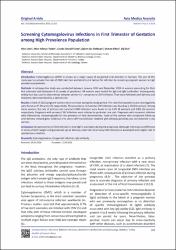Screening cytomegalovirus infections in first trimester of gestation among high prevalence population

Göster/
Erişim
info:eu-repo/semantics/openAccessTarih
2016Yazar
Usta, AkınTaşkın, Mine İslimye
Usta, Ceyda Sancaklı
Dalkıran, Eylem Şen
Kılınç, Osman
Dus, Elif
Üst veri
Tüm öğe kaydını gösterÖzet
Introduction: Cytomegalovirus (CMV) is known as a major cause of congenital viral infection in humans. The aim of this study was to evaluate the rate of CMV infection and identify risk factors for infection by screening pregnant women in high prevalence population.Methods: A retrospective study was conducted between January 2014 and December 2014 in women presenting for their first antenatal visit (between 6-12 weeks of gestation). All women were tested for IgG and IgM antibodies. Subsequently, avidity test was used to discriminate between primary or non-primary CMV infection. They were followed until delivery and newborns were examined by a pediatrician.Results: A total of 3212 pregnant women were screened during the study period. The rate of seropositivity and seronegativity were found as 97.9% and 2.1% respectively. The prevalence of maternal CMV infection was found as 1.1% (34 women). Among these women, the rate of primary and recurrent CMV infection were found to be 0.3% (8 women) and 0.8% (26 women) respectively. Pregnants with primary CMV infection were referred to perinatal care unit. Pregnants with recurrent infection were followed by ultrasonography for the presence of fetal abnormalities. None of the women who completed follow-up until delivery showed gross evidence of in utero CMV transmission. Isolated IgM antibody positivity was not detected in any women.Conclusion: Seroprevalence of CMV infection is very high in our region during the pregnancy. Although, there was no difference in terms of birth weight and gestational age at delivery, detection of primary CMV infection is associated with higher rate of spontaneous abortion. Introduction: Cytomegalovirus (CMV) is known as a major cause of congenital viral infection in humans. The aim of this study was to evaluate the rate of CMV infection and identify risk factors for infection by screening pregnant women in high prevalence population.Methods: A retrospective study was conducted between January 2014 and December 2014 in women presenting for their first antenatal visit (between 6-12 weeks of gestation). All women were tested for IgG and IgM antibodies. Subsequently, avidity test was used to discriminate between primary or non-primary CMV infection. They were followed until delivery and newborns were examined by a pediatrician.Results: A total of 3212 pregnant women were screened during the study period. The rate of seropositivity and seronegativity were found as 97.9% and 2.1% respectively. The prevalence of maternal CMV infection was found as 1.1% (34 women). Among these women, the rate of primary and recurrent CMV infection were found to be 0.3% (8 women) and 0.8% (26 women) respectively. Pregnants with primary CMV infection were referred to perinatal care unit. Pregnants with recurrent infection were followed by ultrasonography for the presence of fetal abnormalities. None of the women who completed follow-up until delivery showed gross evidence of in utero CMV transmission. Isolated IgM antibody positivity was not detected in any women.Conclusion: Seroprevalence of CMV infection is very high in our region during the pregnancy. Although, there was no difference in terms of birth weight and gestational age at delivery, detection of primary CMV infection is associated with higher rate of spontaneous abortion.

















